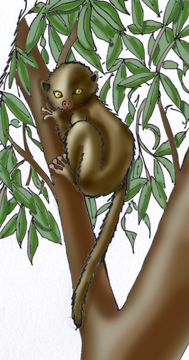

They are found on the island of Madagascar.
They live in wet forests.
They are about 1 foot long (30cm) or 2 feet long including their long tail (60+ cm). They have reddish-brown fur on their backs that is grayer on their belly and gets darker toward the tip of the tail. They have big eyes and ears you can see (as opposed to many lemurs who have ears hidden in tufts of hair.)
They are active at night (nocturnal). They live up in the trees (arboreal), leaping from tree to tree, though sometimes they do come down to the ground. During the day they sleep in tree holes. Males live alone except to mate and have a loud call to mark their territory. Females live with young.
They eat leaves and some fruit, bark and flowers. They feed by pulling the branch to their mouths and chewing the leaves off. They have been known to eat their own dung to get more nutrients from it.
They are killed by snakes eagles, fossa and man.
Females are pregnant for 4.5 months (gestation) and have 1 baby.
They can live more than 10 years in captivity. Unknown in the wild. They are listed as Lower Risk - near threatened.
Kingdom: Animalia
Phylum: Chordata
Subphylum: Vertebrata
Class: Mammalia
Order: Primates
Suborder: Strepsirrhini
Family: Lepilemuridae
Genus: Lepilemur
Species: Lepilemur mustelinus
When you research information you must cite the reference. Citing for websites is different from citing from books, magazines and periodicals. The style of citing shown here is from the MLA Style Citations (Modern Language Association).
When citing a WEBSITE the general format is as follows.
Author Last Name, First Name(s). "Title: Subtitle of Part of Web Page, if appropriate." Title: Subtitle: Section of Page if appropriate. Sponsoring/Publishing Agency, If Given. Additional significant descriptive information. Date of Electronic Publication or other Date, such as Last Updated. Day Month Year of access < URL >.
Amsel, Sheri. "Lemur (Weasel)" Exploring Nature Educational Resource ©2005-2024. December 13, 2024
< http://mail.exploringnature.org/db/view/446 >

